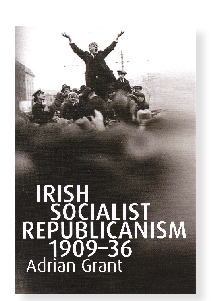Adrian Grant
(Four Courts Press, €50)
ISBN 9781846823619
 This is an important book that tackles big issues. Adrian Grant makes a strong case for the compatibility of socialism and republicanism and argues that splits between left-republicans, radical socialists and communists were based on ‘practicalities’ rather than theoretical differences. But if the problem was one of semantics, why was it so difficult to find a common basis for political action? He himself accepts that the project was partly thrown off course by the Third International’s ‘class against class strategy’ and the Soviet Union’s anti-clerical drive in the critical period from 1929.
This is an important book that tackles big issues. Adrian Grant makes a strong case for the compatibility of socialism and republicanism and argues that splits between left-republicans, radical socialists and communists were based on ‘practicalities’ rather than theoretical differences. But if the problem was one of semantics, why was it so difficult to find a common basis for political action? He himself accepts that the project was partly thrown off course by the Third International’s ‘class against class strategy’ and the Soviet Union’s anti-clerical drive in the critical period from 1929.
But flaws in the analysis go right back to the assertion that Larkin’s arrival in Ireland and the establishment of the Irish Transport and General Workers’ Union heralded the advent of a united Labour movement with a socialist republic as its goal and a capacity to win leadership of the radical nationalist movement. As Grant acknowledges, the impetus for the Irish Trade Union Congress to form a Labour Party in 1912 was to ensure representation in the long-anticipated Home Rule parliament, not to campaign for an Irish Republic.
There is considerable retrospection applied to his very conventional account of the 1913 Lockout, which he characterises as a precursor to the struggle for independence. Grant believes that the workers were defeated by the TUC’s refusal to undertake sympathetic strike action in Britain. The reality is that the Lockout only assumed epic proportions because Ireland was part of the United Kingdom. It was police brutality on Bloody Sunday, the eve of the TUC conference in Manchester, which transformed Dublin into the cockpit of a class struggle, echoing the British strike waves of the previous three years.
There is no denying that the dispute played a vital role in radicalising nationalists such as Patrick Pearse and Eamonn Ceannt, but how far it radicalised wider Irish opinion is debatable. The axis of unity was class-based between Dublin and Britain. The ‘blame the Brits’ argument vociferously promoted by Larkin and Connolly from December 1913 onwards to cover their own strategic errors damaged trade union unity and helped prepare the ground for radical nationalism to overtake Labour after 1914. The advent of war made separatism a serious political project and Dublin became the cockpit of the Irish revolution. Unfortunately, the divisions within Labour inherited from the Lockout continued to hamper its progress. In September 1915, when a by-election occurred in the Harbour division, the most working-class constituency in the city, it proved impossible to agree a Labour candidate. Local councillor P.T. Daly was the obvious choice, but he was by then at daggers drawn with James Connolly, who had beaten him in the succession race to act as Larkin’s deputy during the latter’s sojourn in America. Connolly was already committed to the insurrectionary path and refused the nomination. It was left to three nationalists to fight it out and the victor was a young publican called Alfie Byrne.
The events of 1916 reinforced radical nationalism rather than Labour, and Connolly’s execution did not end the civil war within Dublin labour. Rival camps coagulated around Daly and Connolly’s self-appointed political heir, William O’Brien. Most craft workers in Dublin aligned with the IRB, Sinn Féin and the Irish Volunteers, regarding Labour as the party of the unskilled and low-paid. O’Brien and Daly reluctantly accepted the new primacy of Sinn Féin and the reality that Labour candidates would only have split the radical vote. In Dublin this would probably have allowed the Unionists to win five seats instead of three. Outside Dublin the Labour Party remained what it had started out as in 1912, a political expression of the trade union movement mirroring the politics of local trades councils. Nor did radicalism breed success. The average vote for Labour nationally in the local elections of 1920 was 18% (19% in Belfast, despite the handicap of religious sectarianism). In Dublin Labour secured only 12% of the first-preference vote and owed its 17.5% of seats to Sinn Féin transfers. By now the split in Dublin Labour was public, with Dalyites running under the banner of ‘Trades Council Labour’ and O’Brienites as ‘Republican Labour’. The O’Brienites, whose policies were almost identical to those of Sinn Féin, formed a ruling coalition with that party in the city. The Dalyites supported the Sinn Féin–Republican Labour majority on a number of key issues, including the declaration of the Corporation’s allegiance to Dáil Éireann. The Sinn Féin–Republican Labour alliance could be considered the most practical and successful example of socialist republicanism in our history, but it made little difference to the lives of Dublin’s workers.</>
In 1922 Karl Kautsky said: ‘The deciding battles for Ireland’s independence in recent years were won mainly by the energy and devotion of her proletariat. In spite of this, that proletariat is threatened by the independent state which it won, not with an improvement, but with a further decline of its position.’ This begs the question of whether those workers would have been better off fighting for socialism within the United Kingdom rather than pursuing the chimera of a ‘workers’ and small farmers’ Republic’. Grant provides many insights into the pursuit of that chimera in the 1920s and 1930s that would have been better served by a deeper analysis of the decade before the Treaty. HI
Pádraig Yeates is the author of A city in turmoil: Dublin 1919–21 (Gill & Macmillan, 2012).

